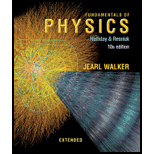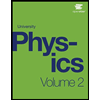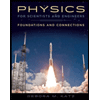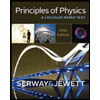
Fundamentals of Physics Extended
10th Edition
ISBN: 9781118230725
Author: David Halliday, Robert Resnick, Jearl Walker
Publisher: Wiley, John & Sons, Incorporated
expand_more
expand_more
format_list_bulleted
Concept explainers
Textbook Question
Chapter 32, Problem 54P
Using the approximations given in Problem 61, find (a) the altitude above Earth’s surface where the magnitude of its magnetic field is 50.0% of the surface value at the same latitude; (b) the maximum magnitude of the magnetic field at the core–mantle boundary. 2900 km below Earth's surface; and the (c) magnitude and (d) inclination of Earth's magnetic field at the north geographic pole, (e) Suggest why the values you calculated for (c) and (d) differ from measured values.
Expert Solution & Answer
Want to see the full answer?
Check out a sample textbook solution
Chapter 32 Solutions
Fundamentals of Physics Extended
Ch. 32 - Figure 32-19a shows a capacitor, with circular...Ch. 32 - Prob. 2QCh. 32 - Prob. 3QCh. 32 - Figure 32-22a shows a pair of opposite spin...Ch. 32 - An electron in an external magnetic field Bext has...Ch. 32 - Prob. 6QCh. 32 - Figure 32-23 shows a face-on view of one of the...Ch. 32 - Prob. 8QCh. 32 - Replace the current loops of Question 8 and Fig....Ch. 32 - Prob. 10Q
Ch. 32 - Figure 32-25 represents three rectangular samples...Ch. 32 - Prob. 12QCh. 32 - Prob. 1PCh. 32 - Prob. 2PCh. 32 - Prob. 3PCh. 32 - Prob. 4PCh. 32 - Prob. 5PCh. 32 - Prob. 6PCh. 32 - Prob. 7PCh. 32 - GO Nonuniform electric flux. Figure 32-30 shows a...Ch. 32 - Prob. 9PCh. 32 - Prob. 10PCh. 32 - Prob. 11PCh. 32 - Prob. 12PCh. 32 - Prob. 13PCh. 32 - Prob. 14PCh. 32 - Prob. 15PCh. 32 - Prob. 16PCh. 32 - Prob. 17PCh. 32 - Prob. 18PCh. 32 - Prob. 19PCh. 32 - Prob. 20PCh. 32 - Prob. 21PCh. 32 - Prob. 22PCh. 32 - Prob. 23PCh. 32 - The magnitude of the electric field between the...Ch. 32 - Prob. 25PCh. 32 - Prob. 26PCh. 32 - Prob. 27PCh. 32 - GO Figure 32-35a shows the current i that is...Ch. 32 - Prob. 29PCh. 32 - Assume the average value of the vertical component...Ch. 32 - In New Hampshire the average horizontal component...Ch. 32 - Figure 32-37a is a one-axis graph along which two...Ch. 32 - SSM WWWIf an electron in an atom has an orbital...Ch. 32 - Prob. 34PCh. 32 - What is the measured component of the orbital...Ch. 32 - Prob. 36PCh. 32 - Prob. 37PCh. 32 - Assume that an electron of mass m and charge...Ch. 32 - A sample of the paramagnetic salt to which the...Ch. 32 - A sample of the paramagnetic salt to which the...Ch. 32 - Prob. 41PCh. 32 - Prob. 42PCh. 32 - Prob. 43PCh. 32 - Figure 32-39 gives the magnetization curve for a...Ch. 32 - Prob. 45PCh. 32 - You place a magnetic compass on a horizontal...Ch. 32 - SSM ILW WWW The magnitude of the magnetic dipole...Ch. 32 - The magnitude of the dipole moment associated with...Ch. 32 - SSMThe exchange coupling mentioned in Module 32-8...Ch. 32 - Prob. 50PCh. 32 - Prob. 51PCh. 32 - Prob. 52PCh. 32 - Prob. 53PCh. 32 - Using the approximations given in Problem 61, find...Ch. 32 - Earth has a magnetic dipole moment of 8.0 1022...Ch. 32 - A charge q is distributed uniformly around a thin...Ch. 32 - A magnetic compass has its needle, of mass 0.050...Ch. 32 - Prob. 58PCh. 32 - Prob. 59PCh. 32 - Prob. 60PCh. 32 - SSMThe magnetic field of Earth can be approximated...Ch. 32 - Prob. 62PCh. 32 - Prob. 63PCh. 32 - A sample of the paramagnetic salt to which the...Ch. 32 - Prob. 65PCh. 32 - Prob. 66PCh. 32 - In Fig. 32-42, a parallel-plate capacitor is being...Ch. 32 - What is the measured component of the orbital...Ch. 32 - Prob. 69PCh. 32 - Prob. 70PCh. 32 - Prob. 71PCh. 32 - Prob. 72PCh. 32 - SSM If an electron in an atom has orbital angular...Ch. 32 - Prob. 74PCh. 32 - Prob. 75PCh. 32 - What are the measured components of the orbital...
Additional Science Textbook Solutions
Find more solutions based on key concepts
What change in magnitude occurs for the vertical component of a ball tossed at an angle upward? For the horizon...
Conceptual Integrated Science
How is the charging time for a capacitor correlated with the initial current? That is, if the initial current i...
Matter and Interactions
9. You have lenses with the following focal lengths: f = 25 mm, 50 mm, 100 mm, and 200 mm. Which lens or pair o...
College Physics: A Strategic Approach (4th Edition)
38. * EST (a) A 50-kg skater initially at rest throws a 4-kg medicine ball horizontally. Describe what happens ...
College Physics
Check Your Understanding The fan blades on a jet engine have a moment of inertia 30.0kgm2 . In 10s, they rotate...
University Physics Volume 1
Give the specific volume of carbon dioxide at 40C for 800kPa and for 1400kPa .
Fundamentals Of Thermodynamics
Knowledge Booster
Learn more about
Need a deep-dive on the concept behind this application? Look no further. Learn more about this topic, physics and related others by exploring similar questions and additional content below.Similar questions
- Is B constant in magnitude for points that lie on a magnetic field line?arrow_forwardA long, straight, horizontal wire carries a left-to-right current of 20 A. If the wire is placed in a uniform magnetic field of magnitude 4.0105 T that is directed vertically downward, what is tire resultant magnitude of the magnetic field 20 cm above the wire? 20 cm below the wire?arrow_forwardThe magnetic field between the poles of a horseshoe electromagnet is uniform and has a cylindrical symmetry about an axis from the middle of the South Pole to the middle of the North Pole. The magnitude of the magnetic field changes as a rate of dB/dt due to the changing current through the electromagnet, Determine the electric field at a distance r from the center.arrow_forward
- How is the percentage change in the strength of the magnetic field across the face of the toroid related to the percentage change in the radial distance from the axis of the toroid?arrow_forwardAssume the region to the right of a certain plane contains a uniform magnetic field of magnitude 1.00 mT and the field is zero in the region to the left of the plane as shown in Figure P22.71. An electron, originally traveling perpendicular to the boundary plane, passes into the region of the field. (a) Determine the time interval required for the electron to leave the field-filled region, noting that the electrons path is a semicircle. (b) Assuming the maximum depth of penetration into the field is 2.00 cm, find the kinetic energy of the electron.arrow_forwardA nonconducting hard rubber circular disk of radius R is painted with a uniform surface charge density tr. It is rotated about its axis with angular speed . (a) Find the magnetic field produced at a point on the axis a distance h meters from the center of the disk, (b) Find the numerical value of magnitude of the magnetic field when =1C/m2 , R = 20 cm, h = 2 cm, and magnetic field of Earth, which is about 1/2 Gauss. =400rad/sec , and compare it with the magnitude ofarrow_forward
- In a region of space, a magnetic field is uniform over space but increases at a constant rate. This changing magnetic field induces an electric field that (a) increases in time, (b) is conservative, (c) is in the direction of the magnetic field, or (d) has a constant magnitude.arrow_forwardCheck Your Understanding Repeat the previous problem with the magnetic field in the x-direction rather than in the z-direction. Check your answers with RHR-1.arrow_forward12.7 Check Your Understanding What is the ratio of the magnetic field produced from using a finite formula over the infinite approximation for an angle of (a) 85°? (b) 89°? The solenoid has 1000 mins in 50 cm with a current of 1.0 A flowing through the coilsarrow_forward
- Calculate the magnitude of the magnetic field at a point 25.0 cm from a long, thin conductor carrying a current of 2.00 A.arrow_forwardDoes increasing the magnitude of a uniform magnetic field through which a charge is traveling necessarily mean increasing the magnetic force on the charge? Does changing the direction of the field necessarily mean a change in the force on the charge?arrow_forwardSketch a plot of the magnitude of the magnetic field as a function of position r for a coax (Fig. P31.27).arrow_forward
arrow_back_ios
SEE MORE QUESTIONS
arrow_forward_ios
Recommended textbooks for you

 Physics for Scientists and Engineers: Foundations...PhysicsISBN:9781133939146Author:Katz, Debora M.Publisher:Cengage Learning
Physics for Scientists and Engineers: Foundations...PhysicsISBN:9781133939146Author:Katz, Debora M.Publisher:Cengage Learning Principles of Physics: A Calculus-Based TextPhysicsISBN:9781133104261Author:Raymond A. Serway, John W. JewettPublisher:Cengage Learning
Principles of Physics: A Calculus-Based TextPhysicsISBN:9781133104261Author:Raymond A. Serway, John W. JewettPublisher:Cengage Learning


Physics for Scientists and Engineers: Foundations...
Physics
ISBN:9781133939146
Author:Katz, Debora M.
Publisher:Cengage Learning

Principles of Physics: A Calculus-Based Text
Physics
ISBN:9781133104261
Author:Raymond A. Serway, John W. Jewett
Publisher:Cengage Learning
Magnets and Magnetic Fields; Author: Professor Dave explains;https://www.youtube.com/watch?v=IgtIdttfGVw;License: Standard YouTube License, CC-BY